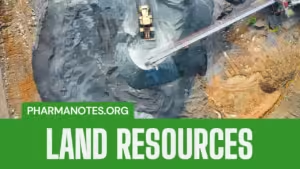Land Resources

Intended Learning Outcomes
At the end of this session, students will be able to
• Explain land as a resource
• Discuss land degradation
• Describe man-induced land-slides
• Explain soil erosion and desertification
Land Resources
• Landforms such as hills, valleys, plains, river basins and wetlands include different resource generating areas that the people living in them depend on
• Many traditional farming societies had ways of preserving areas from which they used resources
• If land is utilized carefully it can be considered a renewable resource
• The roots of trees and grasses bind the soil
• If forests are depleted, or grasslands overgrazed, the land becomes unproductive and wasteland is formed
• Intensive irrigation leads to water logging and salination, on which crops cannot grow
• Land is also converted into a non-renewable resource when highly toxic industrial and nuclear wastes are dumped on it
• Land on earth is as finite as any of our other natural resources
• Man needs land for building homes, cultivating food, maintaining pastures for domestic animals, developing industries to provide goods and supporting the industry by creating towns and cities
• Equally importantly, man needs to protect wilderness area in forests, grasslands, wetlands, mountains, coasts, etc. to protect our vitally valuable biodiversity
Land Degradation
• Farmland is under threat due to more and more intense utilisation
• Every year, between 5 to 7 million hectares of land worldwide is added to the existing degraded farmland
• When soil is used more intensively by farming, it is eroded more rapidly by wind and rain
• Over irrigating farmland leads to salinisation, as evaporation of water brings the salts to the surface of the soil on which crops cannot grow
• Over irrigation also creates water logging of the topsoil so that crop roots are affected and the crop deteriorates
• Use of more and more chemical fertilizers poisons the soil so that eventually the land becomes unproductive
• As urban centers grow and industrial expansion occurs, the agricultural land and forests shrink
• This is a serious loss and has long term ill effects on human civilisation
Soil erosion:
• Characteristics of natural ecosystems such as forests and grasslands depend on the type of soil
• Soils of various types support a wide variety of crops
• The misuse of an ecosystem leads to loss of valuable soil through erosion by the monsoon rains and, to a smaller extent, by wind
• The roots of the trees in the forest hold the soil, Deforestation thus leads to rapid soil erosion
• Soil is washed into streams and is transported into rivers and finally lost to the sea
• The process is more evident in areas where deforestation has led to erosion on steep hill slopes as in the Himalayas and in the Western Ghats
• These areas are called ‘ecologically sensitive areas’ or ESAs
• To prevent the loss of millions of tons of valuable soil every year, it is essential to preserve what remains of our natural forest cover
• It is equally important to reforest denuded areas
• The linkage between the existence of forests and the presence of soil is greater than the forest’s physical soil binding function alone
• The soil is enriched by the leaf litter of the forest
• This detritus is broken down by soil micro-organisms, fungi, worms and insects, which help to recycle nutrients in the system
• Further losses of our soil wealth will impoverish our country and reduce its capacity to grow enough food in future
Summary
• If land is utilized carefully it can be considered a renewable resource
• Land is also converted into a non-renewable resource when highly toxic industrial and nuclear wastes are dumped on it
• To prevent the loss of millions of tons of valuable soil every year, it is essential to preserve what remains of our natural forest cover
• Further losses of our soil wealth will impoverish our country and reduce its capacity to grow enough food in future
Also, Visit:
B. Pharma Notes | B. Pharma Notes | Study material Bachelor of Pharmacy pdf